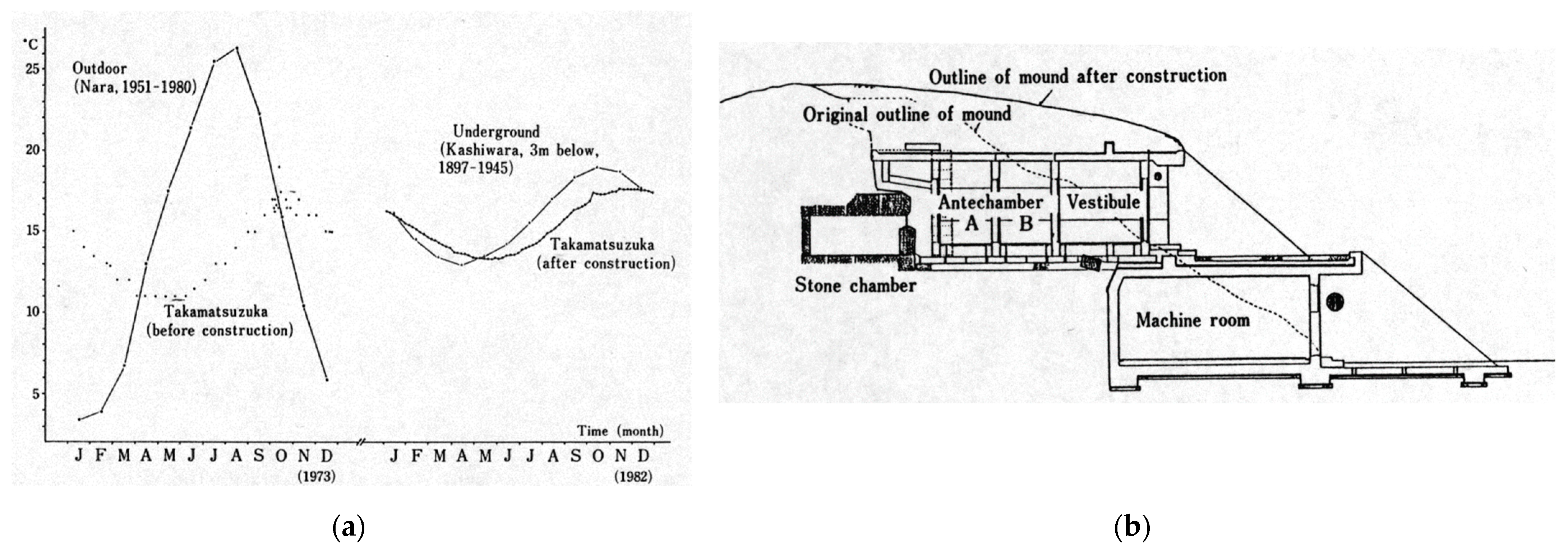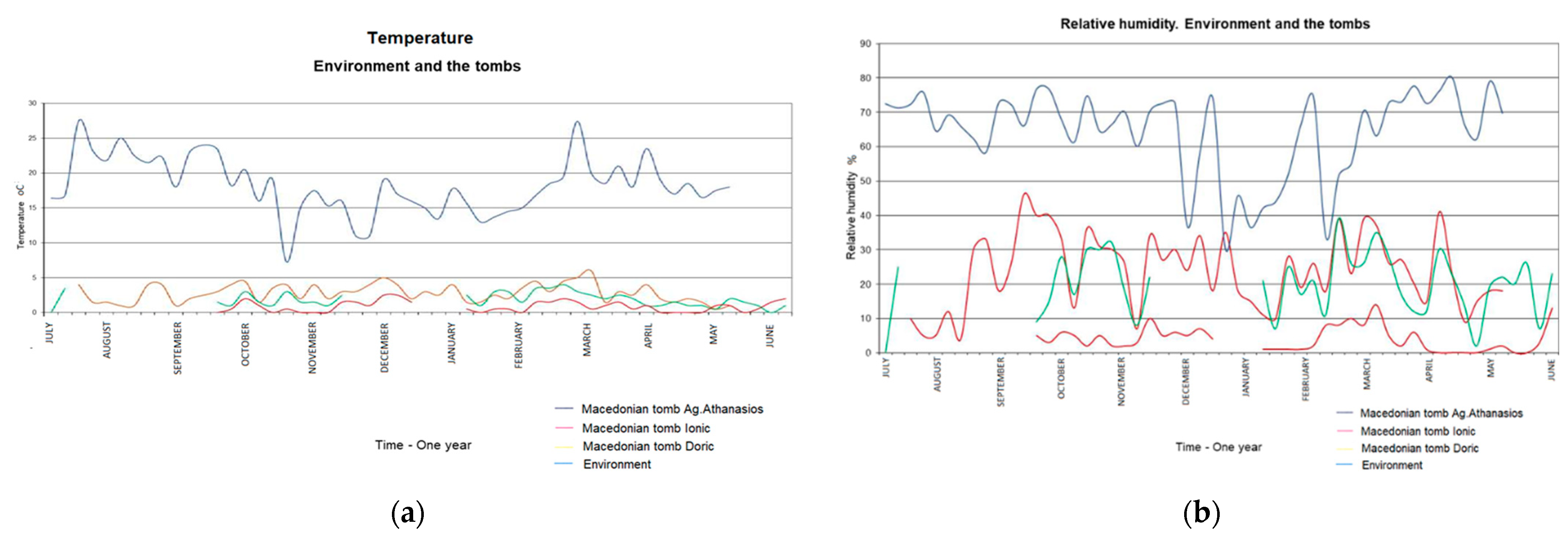Constructing Sustainable Shelters to Safeguard Monuments from Climate Change †
Abstract
:1. Introduction
2. Built Heritage and the Concept of Sustainability and Climate Change Adaptation
3. Why Is a Sustainable Shelter Important?
4. Shelters for Underground Heritage Structures. Case Studies Worldwide
4.1. Royal Macedonian Tombs in Vergina-Greece
4.2. Etruscan Tombs. Tarquinia and Cerveteri, Italy
4.3. Tombs of the Emperors in Japan
4.4. Thracian Tombs in Bulgaria
4.5. The Tombs of Egypt. Valley of the Kings and Queens
5. Evaluation Methodology
- Investigation of the microclimatic conditions with recordings using digital recorders with sensors, evaluation of the recordings and conclusions;
- Simulation in the computer and visualization of the deterioration processes using the simulation program WUFI©, based on the recordings. The simulation program provides data concerning the hygrothermal performance of the tombs’ structural elements;
- Assessment of strategies to control the microclimate. As input, there are used set-points for the museum microclimate proposed by the international guidelines and standards;
- The interpretation of the results leads to conclusions about the effect of the applied microclimate on the hygrothermal performance of the tomb and, consequently, on the resulting deterioration processes;
- The general principles that come out can be applied to similar monuments.
6. Results Concerning the Construction of the Shelters of Macedonian Tombs
- The closed shelter of the tomb of Agios Athanasios seems to have protected the ancient structure to a certain degree. After its construction, the interior microclimate fluctuations were reduced but still remained quite intense. A wooden protective enclosure with a sheet of nylon was constructed. This was later reinforced with a double inlet and foam insulation, with noticeable results in reducing the range of fluctuations;
- The fluctuations were intense in the Ionic tomb C′, since no substantial intervention was made in order to reduce the effect of external climate changes, except for a sheet of nylon on the facade. The open metal shelter made no contribution;
- The fluctuations in the Doric tomb D′ were considerably reduced, as the closed shelter (a wooden enclosure with a sheet of nylon) has positively performed to isolate the interior from the outer environment and remained for a long time after the construction of the open metallic shelter.
- Fluctuations in the external environment have been reduced in the tomb chambers. The shelter did not achieve the stabilization of the internal conditions, but only the minimization of the daily fluctuations;
- The shelter eliminated periodic fluctuations on a daily basis, but not on a weekly basis;
- Absolute moisture values were reduced internally, relatively to the environment;
- Fluctuations were caused by the entrance of people during the working hours of the day.
7. In Search for the Best Solution—Recommendations
- Knowledge of climate change impacts on cultural heritage;
- Dissemination of information;
- Engagement with stakeholders (e.g., communities and decision-makers);
- Monitoring and maintenance;
- Inclusion of climate change in management plans;
- Preservation of values;
- Regulations and guidelines for adaptation;
- Mitigation strategies;
- Financial resources.
- Avoiding the inappropriate use of certain building materials and developing new materials compatible with the historic environment;
- Improving or strengthening monitoring;
- Digital recording of cultural heritage.
7.1. Minimum Requirements That the Shelter Must Provide
- Thermal insulation;
- Protection from overheating in the summer;
- Thermal capacity of the material of the components;
- Resistance to water vapor diffusion;
- Protection from external noise;
- Fire safety (non-flammable materials);
- Expansion properties control, thermal conductivity and water vapor permeability.
7.2. Recommended Actions to Control the Microclimate
- A shelter must ensure the control of microclimate conditions and possibly their correct setting to provide protection from humidity, temperature, solar radiation, micro-organisms, dust, atmospheric pollution, protection from indirect threats, i.e., those that act at an unseen level but are perceived only by their effects;
- Thermal insulation in the shelter is needed to protect the enclosure from overheating in the summer and frost in the winter;
- A sufficient heat capacity of the shelter components to avoid condensation and water formation internally during winter nights and to delay the temperature rise during peak hours;
- The possibility of receiving and removing the moisture generated in the interior (resistance to water vapor diffusion, water vapor barrier, dehydration);
- Double entrance to the shelter, so that one door will be closed when the other opens, in order to minimize the air exchange;
- In the case of mechanical systems operating in order to regulate the variations of temperature and relative humidity, energy consumption should be taken into account. Additionally, constant maintenance and good functioning must be ensured. The type of the shelter predetermines to a significant extent the internal climate and the cost of support systems;
- A mechanical system will manage the temperature and humidity in the shelter. Even if it cannot achieve a constant temperature and relative humidity throughout the year, it could minimize the heat and water flows through the tomb’s walls;
- The energy consumption for maintaining a stable indoor climate can also be affected by interventions in the surrounding area which can modify the microclimate, using artificial barriers and proper plantations for shading and for changing the direction and speed of the winds [2].
8. Conclusions
Author Contributions
Funding
Institutional Review Board Statement
Informed Consent Statement
Data Availability Statement
Conflicts of Interest
References
- Sachs, J.D.; Schmidt-Traub, G.; Mazzucato, M.; Messner, D.; Nakicenovic, N.; Rockström, J. Six Transformations to achieve the Sustainable Development Goals. Nat. Sustain. 2019, 2, 805–814. [Google Scholar] [CrossRef]
- Kyriakou, V. Numerical Study of the Heat and Moisture Transfer in Subterranean Historic Structures and Regulation of the Conditions for Protection and Sustainable Management. Ph.D. Dissertation, Democritus University of Thrace, Department of Civil Engineering, Komotini, Greece, 11 June 2020. Available online: https://www.didaktorika.gr/eadd/handle/10442/47623 (accessed on 10 May 2022).
- National Park Service Climate Change Response Strategy; Climate Change Response Program; National Park Service: Fort Collins, CO, USA, 2010.
- Sabbioni, C.; Brimblecombe, P.; Cassar, M.; the Noah’s Ark Project. The Atlas of Climate Change Impact on European Cultural Heritage: Scientific Analysis and Management Strategies; Anthem: New York, NY, USA, 2012. [Google Scholar]
- Sesana, E.; Gagnon, A.S.; Bertolin, C.; Hughes, J. Adapting cultural heritage to climate change risks: Perspectives of cultural heritage experts in Europe. Geosciences 2018, 8, 305. [Google Scholar] [CrossRef] [Green Version]
- Cassar, M. Climate Change and the Historic Environment. Available online: http://unfccc.int/resource/docs/convkp/conveng.pdf (accessed on 12 September 2021).
- Cassar, M. Environmental Management: Guidelines for Museums and Galleries; Routledge: London, UK; New York, NY, USA, 1995. [Google Scholar]
- Kyriakou, V. Impact of tourism on cultural heritage—Sustainable management. The case of Macedonian tombs. In Proceedings of the International Conference of Trends, Impacts and Policies on Tourism Development, Heraklion, Greece, 15–18 June 2006. [Google Scholar]
- Δημακόπουλος, Ι. Kελύφη προστασίας εν είδη τύμβου. Ένας αρχαιολογικός και μουσειακός χώρος στον τύπο της κρύπτης; Υ.Π.ΠO., Δ/νση Aναστηλώσεως Aρχαίων Μνημείων: Aθήνα, Ελλάδα, 1993. (In Greek) [Google Scholar]
- Ζαγκλανίκη, Λ. Προμελέτη κατασκευής στεγάστρου προστασίας των βασιλικών τάφων της Βεργίνας και αποκατάσταση της τούμπας τους; Υ.Π.ΠO., Aναστήλωση, Συντήρηση, Προστασία Μνημείων και Συνόλων: Aθήνα, Ελλάδα, 1987; Τόμος Β’. (In Greek) [Google Scholar]
- Bettini, G.; Massa, S. Preservation problems. Visitors and deterioration on the painted Etruscan tomb. In Proceedings of the European Symposium Science, Technology and European Cultural Heritage, Bologna, Italy, 13–16 June 1989. [Google Scholar]
- DeCarli, P.; Massa, S.; Nichi, D. Conservative Control of an Archeological Excavation. The Tomb of Demoni Azzurri of Tarquinia. In Proceedings of the European Symposium Science, Technology and European Cultural Heritage, Bologna, Italy, 13–16 June 1989. [Google Scholar]
- Miyake, S. Preservation facilities for the tumulus Takamatsuzuka. In Proceedings of the International Symposium on the Conservation and Restoration of Cultural Property, Tokyo, Japan, 17–21 November 1983; pp. 87–103. [Google Scholar]
- Miura, S.; Saito, H. Temperature and humidity in the tumulus Takamatsuzuka. In Proceedings of the International Symposium on the Conservation and Restoration of Cultural Property, Tokyo, Japan, 17–21 November 1983; pp. 105–115. [Google Scholar]
- Policy for Permanent Preservation of the National Treasure, Takamatsuzuka Tumulus Mural. Available online: https://www.bunka.go.jp/english/policy/cultural_properties/takamatsu_kitora/preservation/ (accessed on 12 September 2021).
- Thracian Tomb of Kazanluk. Unesco World Heritage List. Available online: https://whc.unesco.org/en/list/44 (accessed on 12 September 2021).
- Maekawa, S.; Preusser, F. Environmental Monitoring at the Tomb of Nefertari. In Proceedings of the 10th Triennial Meeting of ICOM Committee for Conservation, Washington, DC, USA, 22–27 August 1993; pp. 616–623. [Google Scholar]
- The Nefertari Tomb. Available online: https://www.nefertaritomb.com/ (accessed on 12 September 2021).
- Kyriakou, V.; Panoskaltsis, V.P. The Impact of the Tumulus on the Preservation of Underground Heritage Structures. In Proceedings of the International Conference Preservation and Restoration of the Environment PRE-XIV, Thessaloniki, Greece, 3–6 July 2018; pp. 158–168. [Google Scholar]
- Kyriakou, V.; Panoskaltsis, V.P. Sustainable Management Approaches for Underground Heritage Structures Threatened by the Environment and the Human Presence. World Rev. Sci. Technol. Sustain. Dev. J. (WRSTSD) 2021, 17, 23–53. [Google Scholar] [CrossRef]
- Kyriakou, V.; Panoskaltsis, V.P. Hygrothermal Performance in Underground Heritage Structures and Issues Related to their Conservation. Int. J. Sci. Tech. Res. Eng. (IJSTRE) 2019, 4, 42–50. [Google Scholar]
- The IPPC Directive. Available online: https://ec.europa.eu/environment/archives/air/stationary/ippc/summary.htm (accessed on 12 September 2021).
- Kyriakou, V.; Panoskaltsis, V.P. Shelters for Monuments: Contribution to Sustainable Management and Future Heritage Preservation. In Proceedings of the ASHRAE International Conference Energy in Buildings EinB2019, Athens, Greece, 14–16 September 2019. [Google Scholar]
- Kyriakou, V.; Panoskaltsis, V.P. Energy Efficiency in Heritage Buildings. In Proceedings of the ASHRAE International Conference Energy in Buildings EinB2018, Athens, Greece, 3 November 2018. [Google Scholar]







Publisher’s Note: MDPI stays neutral with regard to jurisdictional claims in published maps and institutional affiliations. |
© 2022 by the authors. Licensee MDPI, Basel, Switzerland. This article is an open access article distributed under the terms and conditions of the Creative Commons Attribution (CC BY) license (https://creativecommons.org/licenses/by/4.0/).
Share and Cite
Kyriakou, V.; Panoskaltsis, V.P. Constructing Sustainable Shelters to Safeguard Monuments from Climate Change. Environ. Sci. Proc. 2022, 15, 42. https://doi.org/10.3390/environsciproc2022015042
Kyriakou V, Panoskaltsis VP. Constructing Sustainable Shelters to Safeguard Monuments from Climate Change. Environmental Sciences Proceedings. 2022; 15(1):42. https://doi.org/10.3390/environsciproc2022015042
Chicago/Turabian StyleKyriakou, Vasiliki, and Vassilis P. Panoskaltsis. 2022. "Constructing Sustainable Shelters to Safeguard Monuments from Climate Change" Environmental Sciences Proceedings 15, no. 1: 42. https://doi.org/10.3390/environsciproc2022015042
APA StyleKyriakou, V., & Panoskaltsis, V. P. (2022). Constructing Sustainable Shelters to Safeguard Monuments from Climate Change. Environmental Sciences Proceedings, 15(1), 42. https://doi.org/10.3390/environsciproc2022015042





